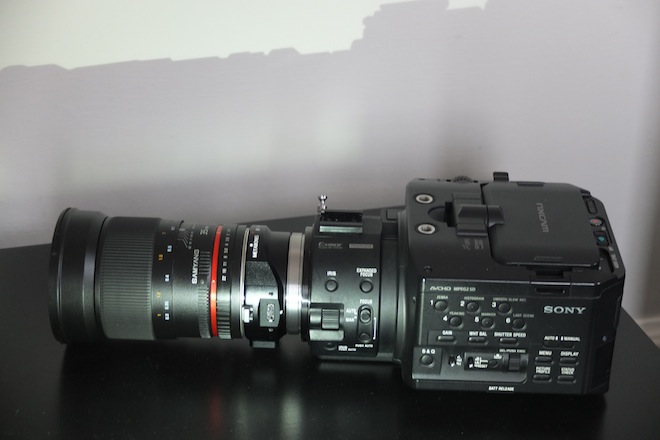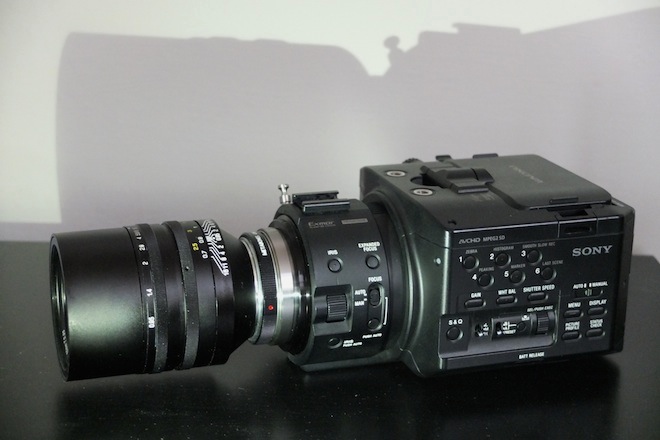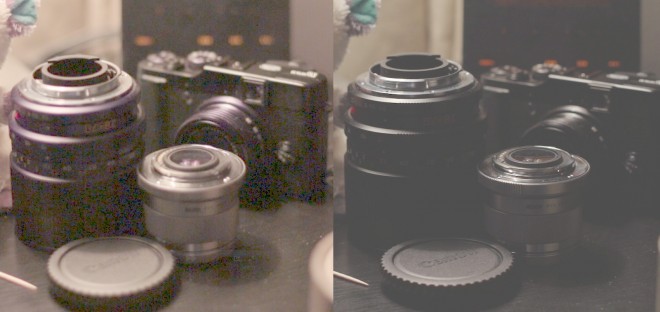
The Sony NXCAM NEX FS100 is the first ever video camera which is competitive with DSLRs on both price and image quality. Yes it took this long!
Now down to $4000 used (£2600) in the US, it is an alternative (for video) to the 5D Mark III at $3500 or £2999.
Now let’s be clear – this isn’t a DSLR ‘killer’. Compared to a GH2 for instance it doesn’t have the stealth factor, or the stills, or the size, or the built in EVF or the $600 price tag or the small lenses like an Olympus 12mm F2. If I was travelling light or shooting in a place where a video camera would attract the wrong kind of attention I’d go for the GH2 100%. A lot of my style of cinematography relies on these GH2 strengths so the FS100 is merely a extra option not a replacement.
Personally I feel the main rival to the FS100 is the 5D Mark III for low budget narrative filmmaking and commercial shoots.
So here’s how I feel they compare:
Features
I was dreading the form factor of the FS100 but it as actually rather good. Compared to the 5D Mark III, the articulated top mounted screen is far more practical, larger and wider. No crouching to get a shot. No hunching over when shooting on a tripod. The expanded focus punch-in and peaking functionality helps enormously with manual focus. The FS100’s body alone is actually very light, no heavier than the 5D Mark III and not all that much larger. It is smaller and much lighter than the C300, even goes in a back pack. The Metabones EOS adapter gives it a fully functioning EF mount. In terms of audio – this may have been improved on the 5D Mark III but the FS100 has two XLR jacks and a whole panel on top dedicated to manual audio control so it is a no-contest there as well. Aside from a few flaps and plastic levers, build quality is actually just fine though not weather proof like the 5D Mark III.
Performance
Surprisingly the FS100 is far better in low light than the 5D Mark III because of the codec. The 5D Mark III has a very good full frame sensor but the video mode just pales in comparison to the FS100. The Canon has no 1080/60p, resolution is extremely poor, the codec is also extremely poor, there’s a ton of crap in the shadows, it doesn’t grade as well and the HDMI output isn’t even clean 1080p like on the Nikon D800.
By comparison the FS100 is in a similar league to the Canon C300’s image. Similar level of resolution, nice dynamic range and has a far better codec than a DSLR despite the fact it is only 24Mbit. The implementation of AVCHD on this camera is the best I’ve ever seen. To show you what I mean, just click the image below and view the large version…
Click the image to view full sized
This is a 100% crop of a graded 1080p image shot on the 5D Mark III (left) and FS100 (right). I lifted the shadows dramatically in post. The frame is shot at ISO 1600 (+9db gain on the FS100) and as you can see the FS100 is virtually noiseless and the codec doesn’t fall apart at all in the lows.
It is an incredible performance for 24Mbit AVCHD. The win at ISO 1600 isn’t just because the FS100’s sensor is so clean at higher sensitivities (because so is the 5D Mark III’s) – it is almost all down to the codec. You get a finer grain of noise when it does occur, too.
Maximum ISO is 16,000 (30db of gain in video camera speak) on the FS100 and base ISO is 500. I prefer to use ISO ratings as it is similar to 35mm film ASA ratings. Gain is nonsense in in film terms, it is a digital video camera term so I won’t be using it. Sony are updating the firmware to have the camera use ISO ratings as well as just showing gain. Hurray!
The only time you see any compression artefacts is on extremely fast pans – the motion blur isn’t as clean as it would be on the GH2 at 80Mbit. But anything without motion blur looks as good as uncompressed HDMI! For locked down shots you can hardly tell this implementation of AVCHD apart from ProRes on an external recorder it is that good.
If you do need to shoot action sequences and rough handheld stuff I do recommend using a Blackmagic HyperDeck Shuttle 2 or Atomos Ninja via HDMI. There you will get 4:2:2 Avid DNxHD on the HyperDeck or ProRes on the Ninja.
Lensing
The FS100 has a Super 35mm sensor and the 5D Mark III is of course larger at photographic 35mm (full frame).
The benefits of the 1.5x crop E-mount of the FS100 are:
- Anything adapts. You can use Leica M mount glass, Canon FD, EF with Metabones EOS adapter, etc.
- You can use APS-C lenses – zooms, primes, the lot. The Canon EF 85mm F1.8 is fantastic.
- You use more of the optimal part of the lens circle – the middle, rather than the outer edges which are softer and with light fall off. (I actually like the edges on full frame though, sometimes a lot!)
- Focus is a bit more manageable than the 5D Mark III, but you get a shallower depth of field all else equal than the GH2
- You get silent AF and IS in video mode with certain lenses. IS on Canon stuff with the Metabones adapter but not silent.
The nice lenses for the FS100 in my opinion and the ones I’ll be using most often are – the Tokina 11-16mm F2.8 for wides, the Samyang 35mm F1.4, Canon FD 50mm F1.4 with anamorphic, Contax Zeiss 85mm F1.4 and the SLR Magic 50mm T0.95 Leica M mount cinema lens.
On the 5D Mark III I can’t use my FDs or Leica stuff because the mount won’t adapt to them. Silly mirror!
The drawbacks of not having a full frame sensor are…
The rendering of your full frame lenses isn’t the same, you get less attractive vignetting and tunnelling of bokeh around the edges which I love – so you have to choose your lenses knowingly if you want that. I’ve spent years getting the ones with a bit of life in them for Micro Four Thirds and will do the same for the FS100. The Olympus PEN-F 38mm F1.8 is pretty nice in this respect. On the GH2 the Voigtlander Nokton 25mm F0.95 has a lot of life in it. The other drawback is of course a less shallow depth of field at the same focal length, focus distance and aperture as you’d get on the 5D Mark III because of the 1.5x crop but it is still plenty shallow enough for all but the most insane shallow DOF junky.

Above: the Sony FS100 with SLR Magic CINE T0.95 Leica M mount
What about the dodgy highlights on the FS100?
This is an enormous topic, fit for another post which I’m preparing for later.
Many many many pages of forums have been filled with people unhappy about the way the FS100 handles roll off and highlights.
Essentially there are 2 issues which you need to be aware of with the FS100’s image:
- Editing or playing back native AVCHD direct from the card can result in clipped highlights and crushed blacks. This is the fault of your Mac rather than the camera. Converting to ProRes with 5DToRGB or using an external recorder are the easiest ways to avoid this.
- Some of the image profile settings on the camera ruin highlight roll off making it very sudden, burn highlights, introduce aliasing around highlights and push all the dynamic range the camera has toward the shadows.
I’ll release a downloadable picture profile on EOSHD which I recommend for best results. I am fine tuning it now and waiting for the end of this month when Sony have the firmware update out allowing sharable picture profiles.
So whilst it is true that the highlights on this camera need protecting, not all of the problems people report on forums about the FS100 are due to the camera, rather due to the way AVCHD is handled by their software.
Next step
I plan to show what the image quality of this camera is like against the 5D Mark III without optical low pass filter and my hacked GH2. It goes without saying that if $4000 is too much, get the GH2. The decision between the 5D Mark III and Sony FS100 on the other hand comes down to how much you need a full frame sensor and stills.
As soon as it stops with the British springtime monsoon, I will go out and shoot something!



